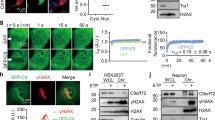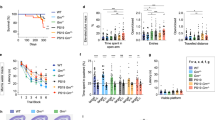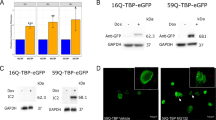Abstract
To elucidate the molecular mechanisms whereby expanded polyglutamine stretches elicit a gain of toxic function, we expressed full-length and truncated DRPLA (dentatorubral-pallidoluysian atrophy) cDNAs with or without expanded CAG repeats in COS-7 cells. We found that truncated DRPLA proteins containing an expanded polyglutamine stretch form filamentous peri- and intranuclear aggregates and undergo apoptosis. The apoptotic cell death was partially suppressed by the transglutaminase inhibitors cystamine and monodansyl cadaverine (but not putrescine), suggesting involvement of a transglutaminase reaction and providing a potential basis for the development of therapeutic measures for CAG-repeat expansion diseases.
This is a preview of subscription content, access via your institution
Access options
Subscribe to this journal
Receive 12 print issues and online access
$209.00 per year
only $17.42 per issue
Buy this article
- Purchase on Springer Link
- Instant access to full article PDF
Prices may be subject to local taxes which are calculated during checkout
Similar content being viewed by others
References
La Spada, A.R., Wilson, E.M., Lubahn, D.B., Harding, A.E. & Fischbeck, K.H. Androgen receptor gene mutations in X-linked spinal and bulbar muscular atrophy. Nature 352, 77–79 (1991).
The Hunington's Disese Collaborative Research Group. A novel gene containing a trinucleotide repeat that is expanded and unstable on Huntington's disease chromosomes. Cell 72, 971–983 (1993).
Orr, H.T. et al. Expansion of an unstable trinucleotide CAG repeat in spinocerebellar ataxia type 1. Nature Genet. 4, 221–226 (1993).
Koide, R. et al. Unstable expansion of CAG repeat in hereditary dentatorubral-pallidoluysian atrophy (DRPLA). Nature Genet. 6, 9–13 (1994).
Nagafuchi, S. et al. Expansion of an unstable CAG trinucleotide on chromosome 12p in dentatorubral and pallidoluysian atrophy. Nature Genet. 6, 14–18 (1994).
Kawaguchi, Y. et al. CAG repeat expansion in a novel gene for Machado-Joseph disease at chromosome 14q32.1. Nature Genet. 8, 221–227 (1994).
Sanpei, K. et al. Identification of the spinocerebellar ataxia type 2 gene using a direct identification of repeat expansion and cloning technique, DIRECT. Nature Genet. 14, 277–284 (1996).
Pulst, S.M. et al. Moderate expansion of a normally biallelic trinucleotide repeat in spinocerebellar ataxia type 2. Nature Genet. 14, 269–276 (1996).
Imbert, G. et al. Cloning of the gene for spinocerebellar ataxia 2 reveals a locus with high sensitivity to expanded CAG/glutamine repeats. Nature Genet. 14, 285–291 (1996).
Zhuchenko, O. et al. Autosomal dominant cerebellar ataxia (SCA6) associated with small polyglutamine expansions in the alpha la-voltage-dependent calcium channel. Nature Genet. 15, 62–69 (1997).
David, G. et al. Cloning of the SCA7 gene reveals a highly unstable CAG repeat expansion. Nature Genet. 17, 65–70 (1997).
Lubahn, D.B. et al. Cloning of human androgen receptor complementary DMA and localization to the X chromosome. Science 240, 327–330 (1988).
Nagafuchi, S. et al. Structure and expression of the gene responsible for the triplet repeat disorder, dentatorubral and pallidoluysian atrophy (DRPLA). Nature Genet. 8, 177–182 (1994).
Mori, Y. et al. Primary structure and functional expression from complementary DNA of a brain calcium channel. Nature 350, 398–402 (1991).
Yazawa, I. et al. Abnormal gene product identified in hereditary dentatorubral-pallidoluysian atrophy (DRPLA) brain. Nature Genet. 10, 99–103 (1995).
Trottier, Y. et al. Cellular localization of the huntington's disease protein and discrimination of the normal and mutated form. Nature Genet. 10, 104–110 (1995).
Servadio, A. . et al. Expression analysis of the ataxin-1 protein in tissues from normal and spinocerebellar ataxia type 1 individuals. Nature Genet. 10, 94–98 (1995).
Onodera, O. . et al. Molecular cloning of a full-length cDNA for dentatorubral-pallidoluysian atrophy and regional expressions of the expanded alleles in the CNS. Am. J. Hum. Genet. 57, 1050–1060 (1995).
Burright, E.N. et al. SCA1 transgenic mice: a model for neurodegeneration caused by an expanded CAG trinucleotide repeat. Cell 82, 937–948 (1995).
Ikeda, H. et al. Expanded polyglutamine in the Machado-Joseph disease protein induces cell death in vitro and in vivo. Nature Genet. 13, 196–202 (1996).
Mangiarini, L. et al Exon 1 of the HD gene with an expanded cagr repeat is sufficient to cause a progressive neurological phenotype in transgenic mice. Cell 87, 493–506 (1996).
Davies, S.W. et al. Formation of neuronal intranuclear inclusions underlies the neurological dysfunction in mice transgenic for the HD mutation. Cell 90, 537–548 (1997).
Perutz, M.F., Johnson, T., Suzuki, M. & Finch, J.T. Glutamine repeats as polar zippers: their possible role in inherited neurodegenerative diseases. Proc. Natl. Acad. Sci. USA 91, 5355–5358 (1994).
Stott, K., Blackburn, J.M., Butler, P.J. & Perutz, M.F. Incorporation of glutamine repeats makes protein oligomerize: implications for neurodegenerative diseases. Proc. Natal. Acad. Sci. USA 92, 6509–6513 (1995).
Kahlem, P., Terre, C., Green, H. & Djian, P. Peptides containing glutamine repeats as substrates for transglutaminase-catalyzed cross-linking: relevance to diseases of the nervous system. Proc. Natl. Acad. Sci. USA 93, 14580–14585 (1996).
Naito, H. & Oyanagi, S. Familial myoclonus epilepsy and choreoathetosis: hereditary dentatorubral-pallidoluysian atrophy. Neurol. 32, 798–807 (1982).
Ikeuchi, T. et al. Dentatorubral-pallidoluysian atrophy (DRPLA): Clinical features are closely related to unstable expansions of trinucleotide (CAG) repeat. Ann. Neurol. 37, 769–775 (1995).
Lorand, L. et al. Specificity of guinea pig liver transglutaminase for amine substrates. Biochemistry 18, 1756–1765 (1979).
Dickson, R.B., Willingham, M.C. & Pastan, I. Binding and internalization of 125l-cc2-macroglobulin by cultured fibroblast. J. Biol. Chem. 256, 3454–3459 (1981).
Kleman, J.-P., Aeschlimann, D., Paulsson, M. & van der Rest, M. Transglutaminase-catalyzed cross linking of fibrils of collagen V/XI in A 204 rhabdomyosarcoma cell. Biochemistry 34, 13768–13775 (1995).
Paulson, H.L. et al. Intranuclear inclusions of expanded polyglutamine protein in spinocerebellar ataxia type 3. Neuron 19, 333–334 (1997).
Scherzinger, E. et al. Huntingtin-encoded polyglutamine expansions form amyloid-like protein aggregates in vitro and in vivo. Cell 90, 549–558 (1997).
Onodera, O. et al. Oligomerization of expanded-polyglutamine domain fluorescent fusion proteins in cultured mammalian cells. Biochem.Biophy. Res. Commun. 238, 599–605 (1997).
Jackson, M., et al. The cortical neuritic pathology of Huntington's disease. Neuropatho. Appl. Neurobiol. 21, 18–26 (1995).
DiFiglia, M. et al. Aggregation of Huntingtin in neuronal intranuclear inclusions and dystrophic neurites in brain. Science 277, 1990–1993 (1997).
Paulson, H.L. et al. Machado-Joseph disease gene product is a cytoplasmic protein widely expressed in brain. Ann. Neurol. 41, 453–462 (1997).
Goldberg, Y.P. et al. Cleavage of huntingtin by apopain, aproapoptotic cysteine protease, is modulated by the polyglutamine tract. Nature Genet. 13, 442–449 (1996).
Mizushima, S. & Nagata, S. . pEF-BOS, a powerful mammalian expression vector. Nucleic Acids Res. 18, 5322 (1990).
Author information
Authors and Affiliations
Corresponding author
Rights and permissions
About this article
Cite this article
Igarashi, S., Koide, R., Shimohata, T. et al. Suppression of aggregate formation and apoptosis by transglutaminase inhibitors in cells expressing truncated DRPLA protein with an expanded polyglutamine stretch. Nat Genet 18, 111–117 (1998). https://doi.org/10.1038/ng0298-111
Received:
Accepted:
Issue Date:
DOI: https://doi.org/10.1038/ng0298-111
This article is cited by
-
Transglutaminase 2 has opposing roles in the regulation of cellular functions as well as cell growth and death
Cell Death & Disease (2016)
-
Inhibition of Transglutaminase Exacerbates Polyglutamine-Induced Neurotoxicity by Increasing the Aggregation of Mutant Ataxin-3 in an SCA3 Drosophila Model
Neurotoxicity Research (2015)
-
Computational investigation of molecular mechanism and neuropathological implications in Huntington disease
Molecular and Cellular Biochemistry (2015)
-
Autosomal dominant cerebellar ataxia type III: a review of the phenotypic and genotypic characteristics
Orphanet Journal of Rare Diseases (2013)
-
Transglutaminase is a Therapeutic Target for Oxidative Stress, Excitotoxicity and Stroke: A new Epigenetic Kid on the Cns Block
Journal of Cerebral Blood Flow & Metabolism (2013)



